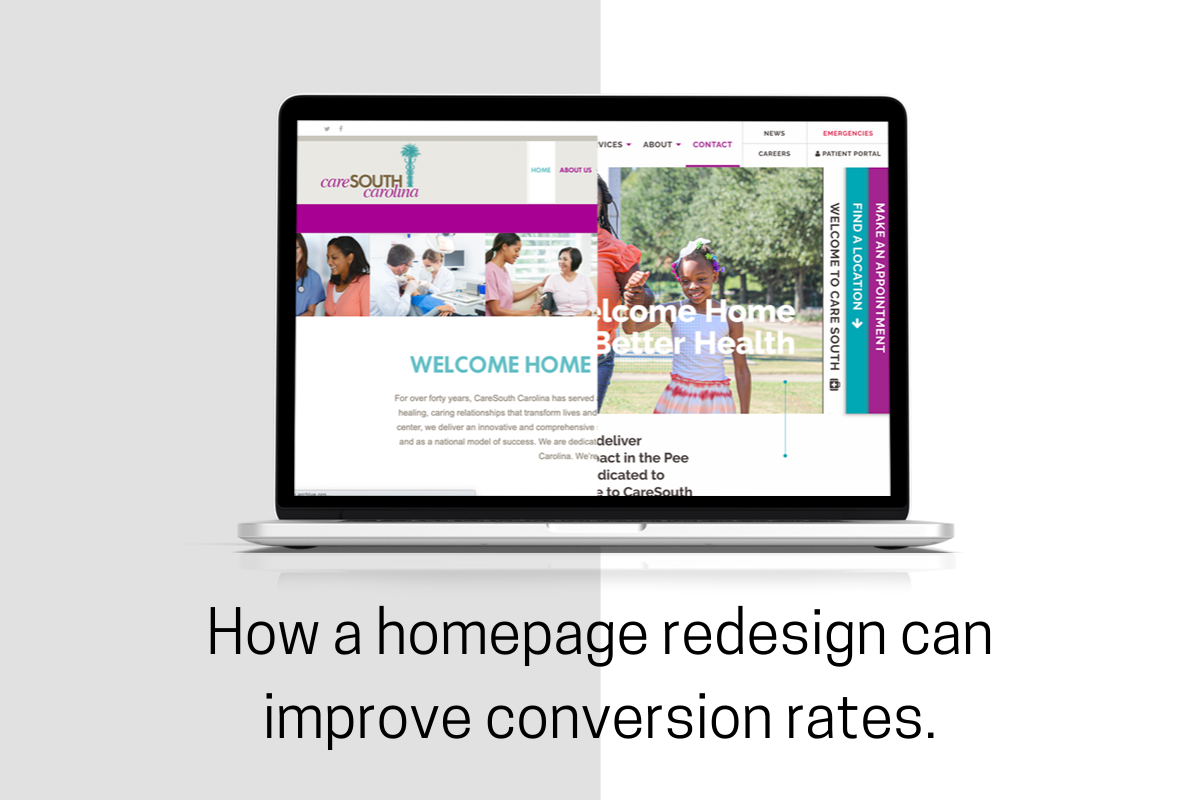Today’s web users are more tech-savvy than ever. If your current website isn’t getting the traffic, traction or sales leads that you are looking for, it might be time for a homepage redesign that improves the initial user experience and focuses on optimization.
Companies who are thoughtful about their redesign are twice as likely to see an increase in sales.
To put it bluntly, a tactical, creative homepage redesign seeks to achieve the following:
- conversions
- conversions
- and more conversions!
It’s that simple.
So...what is a conversion, exactly?
A conversion is any desired action that a user takes on your website. This could be simply filling out a form, or it could be making a purchase. Conversions are the desired, actionable steps that a user takes on his or her web journey.
LET’S DISCUSS YOUR HOMEPAGE REDESIGN
What are the key elements of a solid homepage redesign?
A successful homepage redesign will be visually eye-catching, easy to navigate, and filled with engaging content with keywords and strong calls to action.
Creating a new, optimized homepage is centered around two key areas. Let’s drill into those a bit:
REdesigning: The Visual Experience
An uncluttered, streamlined homepage that pops from the moment you engage with it is key.
1. Speed Optimization
Speed actually plays a role in the visual experience.
You don’t want a slow, clunky site that makes users wait to see what’s next. Even a 1 second delay in site speed can cause a 7% reduction in conversions. Delay that user experience even just a few more seconds, and the user drop-out rate exponentially increases. You want to make sure your back end development is performing at its optimum speed, and performance is key. Here is a resource to check site speed.
Food for thought: when streamlined page functionality and various privacy settings are built in, site speed slows down. It’s a balancing act of having an engaging site while keeping speed at an optimal level.
2. Visual Optimization
Now to the visual experience piece.
According to a recent study, it takes less than 0.2 seconds for a website visitor to decide if they like the website or not. Making sure that you create a seamless, engaging-yet-not-overwhelming visual experience for your user is key.
Why?
Let’s say you’re shopping at a new brick and mortar store. Walking in, you quickly discover that the store is not organized and the products are hard to find or navigate through. You’re outta there.
Walking back out onto main street, you can’t help but see a stylish shop with a snappy window display. Upon entering, you’re greeted warmly by the staff. Your eyes light up as you easily navigate the store, picking up many tastefully arranged items of interest along the way.
It’s easy to see that the snappy boutique created multiple conversions. You were drawn in, felt welcomed, the shop was easy to navigate, and the products were easy to find and purchase.
A website is no different.
A few key visual ingredients of a homepage redesign are:
- Strong color palette with cohesive design elements: Only use 2-3 colors across the board. Keep your design elements like typography and imagery consistent and uncluttered.
- Lots of white space: This equates to “visual breathing room” for your user; a space to take in the information you’ve just shared, and hopefully drive conversions along the way.
- Hero images: We’ve discussed the importance of using strong photography that represents your brand in your digital marketing strategy. Your website redesign should grab that idea and run with it. Hero images are the bread and butter of the visual experience. Make sure that the photography you incorporate does the following heavy lifting:
- grabs and engages your audience
- tells the “experience” story you want to convey
- encourages users to keep moving down the page
REdesigning: The Content Experience
If a homepage’s visual experience is the eye candy that hooks you, the web content itself can be thought of as the “info-nuggets” that keep you engaged and hungry for more.
So, what are the key content elements that drive those all-important conversions?
1. Engaging Content:
You’ll want to create content that is easy to read, but also engaging. Draw users in with digestible nuggets of wisdom that a user can take away as little “ah ha” moments.
When considering content, ask yourself what questions your potential users might have:
- What sets you apart from the competition?
- What value do you add?
- Why should people care?
Also, take a look at your Google My Business page reviews and social media communications. What stands out? What topics consistently bubble up? What questions do people have about your product or service? How have you made customers feel taken care of or satisfied their needs?
Gather up these themes and let it inform your content across the board.
2. SEO Rich Content
To get the traffic, leads and sales that you are aiming for, it’s important to use SEO-rich keywords in all aspects of your homepage web content.
What are SEO rich keywords?
These are targeted words and phrases that people search for within your product or service search context.
Where can you find out what keywords to use for your business?
- First, you want to do keyword research. This involves brainstorming key phrases that you think users would use when searching for your product or service.
- Next, search those keywords or phrases on Google, then scroll down to see what related terms and keywords are often used.
- Finally, run the analytics on those search terms. This blog highlights how to use Google Console as well as Google Analytics to track your site’s performance and take your SEO to a whole new level.
Once you have a list of top-ranking keywords, incorporate them into the following:
- Headings
- Subheadings
- Titles
- Photo captions
- Web content
Calls to Action
Last but certainly not least, use clear calls to action (CTA’s) to help guide your users to those all-important conversions.
Whether it’s to sign up for your e-newsletter, download content, or click to purchase a product...you won’t achieve the results you want if you don’t ask!
A few tips for writing CTA’s:
- Create a sense of urgency
- Make it low-risk
- Make it convincing
- Make it pop off the page (using a button or hyperlink prompt)
NEED HELP WITH YOUR WEB REDESIGN?
We hope these homepage redesign tips for optimizing conversions helps you envision a more successful version of your business and website. Want to chat more with our team at ALINE about your digital marketing strategy? Don’t hesitate to reach out!


 Carolyn Baughman
Carolyn Baughman